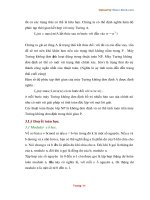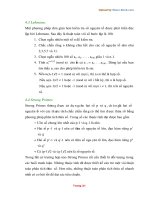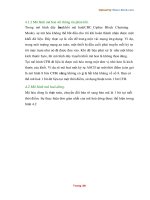Bảo mật thông tin: Các phương pháp mã hóa - phần 2 potx
Bạn đang xem bản rút gọn của tài liệu. Xem và tải ngay bản đầy đủ của tài liệu tại đây (1.55 MB, 77 trang )
McGraw-Hill
©
The McGraw-Hill Companies, Inc., 2000
Bảo mật hệ thống thông tin
CÁC PHƯƠNG PHÁP MÃ HÓA
PHẦN 2
1/2011
1/2011
5.2
Objectives
❏ To distinguish between traditional and modern
symmetric-key ciphers.
❏ To introduce modern block ciphers and discuss
their characteristics.
❏ To explain why modern block ciphers need to be
designed as substitution ciphers.
❏ To introduce components of block ciphers such as
P-boxes and S-boxes.
Chapter 5
5.3
Objectives (Continued)
❏ To discuss product ciphers and distinguish
between two classes of product ciphers: Feistel
and non-Feistel ciphers.
❏ To discuss two kinds of attacks particularly
designed for modern block ciphers: differential
and linear cryptanalysis.
❏ To introduce stream ciphers and to distinguish
between synchronous and nonsynchronous stream
ciphers.
❏ To discuss linear and nonlinear feedback shift
registers for implementing stream ciphers.
Chapter 5
5.4
5-1 MODERN BLOCK CIPHERS
5-1 MODERN BLOCK CIPHERS
A symmetric-key modern block cipher encrypts an
A symmetric-key modern block cipher encrypts an
n-bit block of plaintext or decrypts an n-bit block of
n-bit block of plaintext or decrypts an n-bit block of
ciphertext. The encryption or decryption algorithm
ciphertext. The encryption or decryption algorithm
uses a k-bit key.
uses a k-bit key.
5.1.1 Substitution or Transposition
5.1.2 Block Ciphers as Permutation Groups
5.1.3 Components of a Modern Block Cipher
5.1.4 Product Ciphers
5.1.5 Two Classes of Product Ciphers
5.1.6 Attacks on Block Ciphers
Topics discussed in this section:
Topics discussed in this section:
5.5
Figure 5.1 A modern block cipher
5.1 Continued
5.6
5.1 Continued
Example 5.1
How many padding bits must be added to a message of 100
How many padding bits must be added to a message of 100
characters if 8-bit ASCII is used for encoding and the block
characters if 8-bit ASCII is used for encoding and the block
cipher accepts blocks of 64 bits?
cipher accepts blocks of 64 bits?
Encoding 100 characters using 8-bit ASCII results in an 800-
Encoding 100 characters using 8-bit ASCII results in an 800-
bit message. The plaintext must be divisible by 64. If | M | and
bit message. The plaintext must be divisible by 64. If | M | and
|Pad| are the length of the message and the length of the
|Pad| are the length of the message and the length of the
padding,
padding,
Solution
Solution
5.7
A modern block cipher can be designed to act as a
substitution cipher or a transposition cipher.
5.1.1 Substitution or Transposition
To be resistant to exhaustive-search attack,
a modern block cipher needs to be
designed as a substitution cipher.
Note
5.8
Example 5.2
5.1.1 Continued
Suppose that we have a block cipher where
Suppose that we have a block cipher where
n
n
= 64. If there
= 64. If there
are 10 1’s in the ciphertext, how many trial-and-error tests
are 10 1’s in the ciphertext, how many trial-and-error tests
does Eve need to do to recover the plaintext from the
does Eve need to do to recover the plaintext from the
intercepted ciphertext in each of the following cases?
intercepted ciphertext in each of the following cases?
a. The cipher is designed as a substitution cipher.
a. The cipher is designed as a substitution cipher.
b. The cipher is designed as a transposition cipher.
b. The cipher is designed as a transposition cipher.
a.
a.
In the first case, Eve has no idea how many 1’s are in the
In the first case, Eve has no idea how many 1’s are in the
plaintext. Eve needs to try all possible 2
plaintext. Eve needs to try all possible 2
64
64
64-bit blocks to
64-bit blocks to
find one that makes sense.
find one that makes sense.
Solution
Solution
b.
b.
In the second case, Eve knows that there are exactly 10 1’s
In the second case, Eve knows that there are exactly 10 1’s
in the plaintext. Eve can launch an exhaustive-search
in the plaintext. Eve can launch an exhaustive-search
attack using only those 64-bit blocks that have exactly 10
attack using only those 64-bit blocks that have exactly 10
1’s.
1’s.
5.9
Is a modern block cipher a group?
5.1.2 Block Ciphers as Permutation Groups
Full-Size Key Transposition Block Ciphers
In a full-size key transposition cipher We need to have n!
possible keys, so the key should have log
2
n! bits.
Example 5.3
Show the model and the set of permutation tables for a 3-bit
Show the model and the set of permutation tables for a 3-bit
block transposition cipher where the block size is 3 bits.
block transposition cipher where the block size is 3 bits.
Solution
Solution
The set of permutation tables has 3! = 6 elements, as shown in
The set of permutation tables has 3! = 6 elements, as shown in
Figure 5.2.
Figure 5.2.
5.10
Figure 5.2 A transposition block cipher modeled as a permutation
5.1.2 Continued
5.11
Full-Size Key Substitution Block Ciphers
A full-size key substitution cipher does not transpose bits;
it substitutes bits. We can model the substitution cipher as
a permutation if we can decode the input and encode the
output.
5.1.2 Continued
Example 5.4
Show the model and the set of permutation tables for a 3-bit
Show the model and the set of permutation tables for a 3-bit
block substitution cipher.
block substitution cipher.
Figure 5.3 shows the model and the set of permutation tables.
Figure 5.3 shows the model and the set of permutation tables.
The key is also much longer,
The key is also much longer,
log
log
2
2
40,320
40,320
= 16
= 16
bits.
bits.
Solution
Solution
5.12
Figure 5.3 A substitution block cipher model as a permutation
5.1.2 Continued
5.13
5.1.2 Continued
A full-size key n-bit transposition cipher or a
substitution block cipher can be modeled
as a permutation, but their key sizes are different:
Note
Transposition: the key is log
2
n! bits long.
Substitution: the key is log
2
(2
n
)! bits long.
A partial-key cipher is a group under the
composition operation if it is a subgroup
of the corresponding full-size key cipher.
Note
5.14
Modern block ciphers normally are keyed substitution
ciphers in which the key allows only partial mappings
from the possible inputs to the possible outputs.
5.1.3 Components of a Modern Block Cipher
A P-box (permutation box) parallels the traditional
transposition cipher for characters. It transposes bits.
P-Boxes
5.15
Figure 5.4 Three types of P-boxes
5.1.3 Continued
5.16
Example 5.5
5.1.3 Continued
Figure 5.5 The possible mappings of a 3 × 3 P-box
Figure 5.5 shows all 6 possible mappings of a 3 × 3 P-box.
Figure 5.5 shows all 6 possible mappings of a 3 × 3 P-box.
5.17
5.1.3 Continued
Table 5.1 Example of a permutation table for a straight P-box
Straight P-Boxes
5.18
Example 5.6
5.1.2 Continued
Design an 8 × 8 permutation table for a straight P-box that
Design an 8 × 8 permutation table for a straight P-box that
moves the two middle bits (bits 4 and 5) in the input word to
moves the two middle bits (bits 4 and 5) in the input word to
the two ends (bits 1 and 8) in the output words. Relative
the two ends (bits 1 and 8) in the output words. Relative
positions of other bits should not be changed.
positions of other bits should not be changed.
Solution
Solution
We need a straight P-box with the table [4 1 2 3 6 7 8 5].
We need a straight P-box with the table [4 1 2 3 6 7 8 5].
The relative positions of input bits 1, 2, 3, 6, 7, and 8 have not
The relative positions of input bits 1, 2, 3, 6, 7, and 8 have not
been changed, but the first output takes the fourth input and
been changed, but the first output takes the fourth input and
the eighth output takes the fifth input.
the eighth output takes the fifth input.
5.19
Compression P-Boxes
5.1.3 Continued
A compression P-box is a P-box with n inputs and m
outputs where m < n.
Table 5.2 Example of a 32 × 24 permutation table
5.20
5.1.3 Continued
Table 5.2 Example of a 32 × 24 permutation table
Compression P-Box
5.21
Expansion P-Boxes
5.1.3 Continued
An expansion P-box is a P-box with n inputs and m
outputs where m > n.
Table 5.3 Example of a 12 × 16 permutation table
5.22
5.1.3 Continued
P-Boxes: Invertibility
A straight P-box is invertible, but compression and
expansion P-boxes are not.
Note
5.23
Example 5.7
5.1.3 Continued
Figure 5.6 shows how to invert a permutation table
Figure 5.6 shows how to invert a permutation table
represented as a one-dimensional table.
represented as a one-dimensional table.
Figure 5.6 Inverting a permutation table
5.24
Figure 5.7 Compression and expansion P-boxes are non-invertible
5.1.3 Continued
5.25
5.1.3 Continued
S-Box
An S-box (substitution box) can be thought of as a
miniature substitution cipher.
An S-box is an m × n substitution unit, where m and
n are not necessarily the same.
Note









